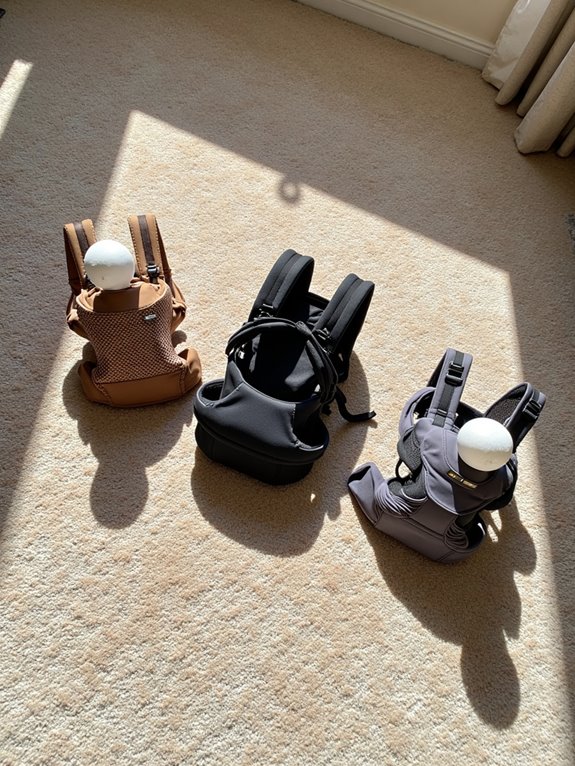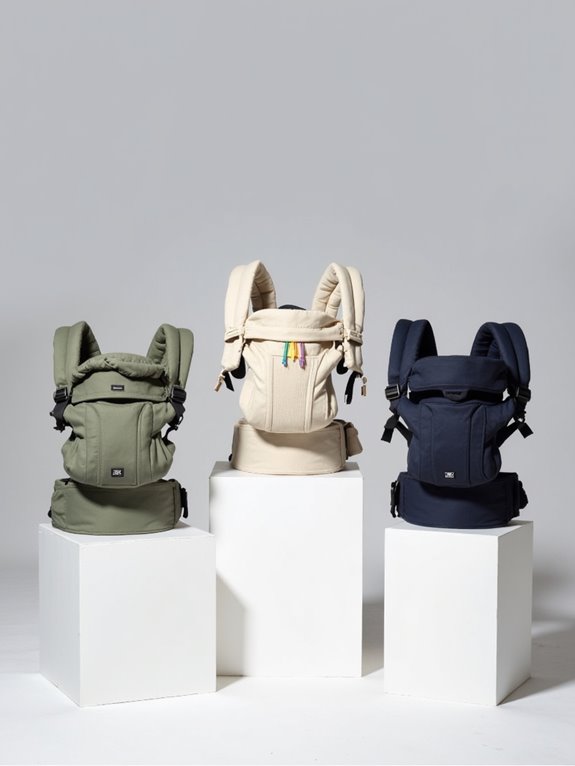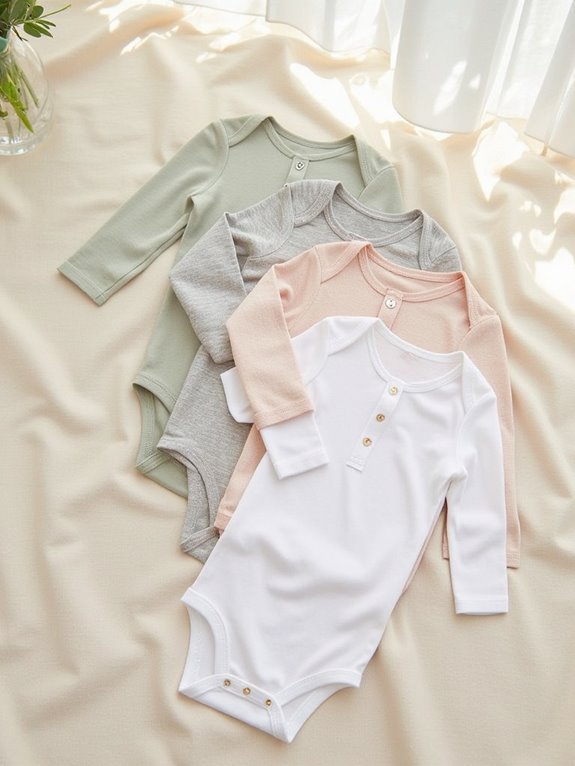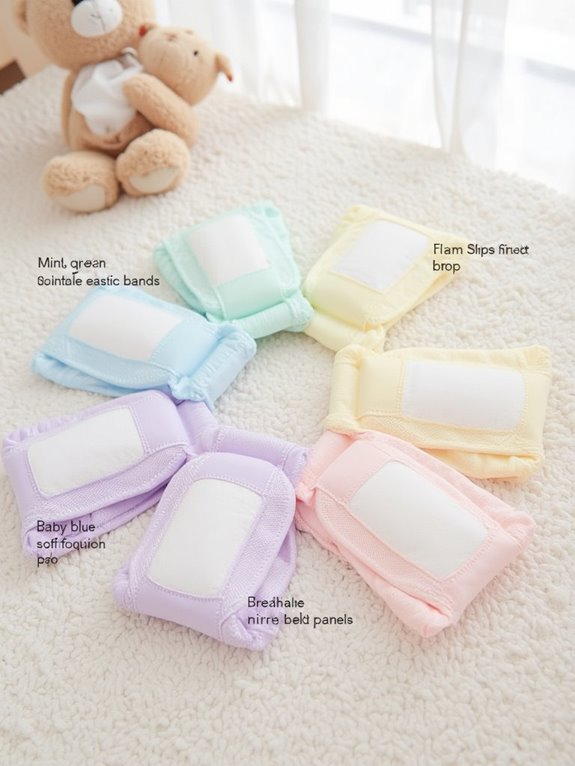Links below are affiliate links. We earn a commission on purchases at no extra cost to you. Although our opinions are based on curated research, we haven't used these products. Articles generated with AI.

The 3 Best Baby Carriers of 2025, According to Parents and Experts
Based on extensive parent feedback and expert testing, you’ll find three standout baby carriers for 2025: The Baby Sling Carrier with Safety Buckle (8-30 lbs) offers reinforced stitching and secure positioning for newborns, the BabyBjörn Mini (3D Jersey) excels with its lightweight 1.76 lb design and quick-drying materials, and the MOMTORY 6-in-1 impresses with its versatile 7-50 lb weight range and multiple carrying positions. Each model features industry-standard safety certifications and ergonomic support. Our detailed analysis below explores their unique features and performance metrics.
Key Takeaways
- Safety certification standards and ergonomic M-shaped seating are crucial factors experts use to evaluate top baby carriers.
- The best carriers offer multiple carrying positions and support weights from 8-45 pounds throughout infant-to-toddler stages.
- Premium carriers feature breathable materials, moisture-wicking fabrics, and ventilation panels for optimal temperature regulation.
- Expert-recommended carriers include quick-release safety buckles and reinforced stitching at stress points for maximum security.
- Top-rated carriers provide adjustable straps, padded support, and customizable fit settings for both parent and baby comfort.
Baby Sling Carrier with Safety Buckle, 8-30 lbs
Baby Sling Carrier 8-30 lbs, Newborn Nursing, Toddler Carrier with Safety Buckle, Knob Tech Baby...
- ERGONOMICALLY DESIGNED FOR PARENTAL COMFORT - The BabieBoo Baby Sling Carrier ensures stress-free arm and back support, allowing parents to carry their little ones for...
- QUICK & EASY USE - Get your baby securely snuggled in the BabieBoo Baby Carrier in under 30 seconds, eliminating fuss and crying. Always support your child's back with...
- CONVINIENT BREASTFEEDING - Our sling doubles as a discreet nursing cover, allowing for easy breastfeeding without needing to remove your baby from the carrier. Stay...
The Baby Sling Carrier with Safety Buckle serves as an ideal choice for parents who need to carry infants and toddlers weighing between 8-30 pounds while maintaining their mobility and comfort.
You’ll find this carrier equipped with key safety features, including an easy-access buckle and Knob Tech Baby Closer system for secure positioning. The ergonomic design distributes weight evenly across your back and hips, while adjustable straps and width settings accommodate your growing child from newborn to 36 months. The breathable cotton-nylon blend wicks moisture and maintains softness through multiple washes. At just 14.5 ounces, it folds compactly into your diaper bag for convenient transport during errands or travel.
Best For: Parents seeking a lightweight, adjustable baby carrier that provides comfort and security for both caregiver and child during daily activities, especially suitable for those with infants and toddlers between 8-30 pounds.
Pros:
- Ergonomic design with adjustable straps and width settings ensures customized fit and even weight distribution
- Quick and easy to use with safety buckle system, taking under 30 seconds to secure baby
- Versatile functionality including nursing cover capability and multiple carrying positions
Cons:
- Hand wash only care instructions may be inconvenient for some users
- Tension dial adjustment requires extra effort to modify
- Weight limit of 30 pounds may not accommodate larger toddlers for extended use
BabyBjörn Baby Carrier Mini, 3D Jersey, Light Beige
BabyBjörn Baby Carrier Mini, 3D Jersey, Light Beige | Newborn Carrier (7-25 lbs), Ergonomic,...
- Baby Carrier Mini is available in four super-soft materials: 3D jersey, 3D mesh, satin-woven cotton and a soft and lustrous woven blend, all developed to enhance the...
- Baby Carrier Mini is small, soft and simple to use. It’s designed to meet a very young baby’s great need for closeness.
- Baby Carrier Mini is suitable until your child is one year old or until they reach a weight of 24 lbs (11 kg) and/or a height of 29.5 in (75 cm).
Designed for parents seeking a lightweight carrier for their newborns up to 12 months old, BabyBjörn’s Baby Carrier Mini in 3D Jersey offers exceptional versatility through its face-in and face-out carrying positions.
You’ll find this 1.76-pound carrier supports babies from 7-24 pounds with a soft, breathable fabric that maintains your child’s natural C-curve spine position. The carrier’s easy-on, easy-off design lets you make quick adjustments between users, while the machine-washable material keeps maintenance simple. With dimensions of 19 x 11 x 12 inches, it’s compact enough for daily errands yet supportive enough for your baby’s developing hips and legs.
Best For: New parents seeking a lightweight, easy-to-use carrier for frequent short wearing sessions with newborns and infants up to 12 months old.
Pros:
- Extremely lightweight (1.76 lbs) and easy to put on/take off with quick adjustments between different users
- Soft, breathable 3D Jersey fabric that’s machine washable and supports baby’s natural spine position
- Versatile design allows both face-in and face-out carrying positions as baby grows
Cons:
- Limited longevity with 24-pound weight limit and 12-month age recommendation
- May not provide enough support for extended wearing periods compared to more structured carriers
- Some users report fit issues for larger-busted breastfeeding mothers
MOMTORY 6-in-1 Baby Carrier for Newborn to Toddler
Baby Carrier, MOMTORY Safety-Certified 6-in-1 Baby Carrier Newborn to Toddler, Adjustable Detachable...
- 𝐅𝐫𝐨𝐦 𝐁𝐚𝐛𝐲 𝐭𝐨 𝐓𝐨𝐝𝐝𝐥𝐞𝐫, 𝐎𝐮𝐫 𝐂𝐚𝐫𝐫𝐢𝐞𝐫'𝐬 𝐆𝐨𝐭 𝐘𝐨𝐮!: It is a versatile baby...
- 𝐄𝐟𝐟𝐨𝐫𝐭𝐥𝐞𝐬𝐬 𝐒𝐚𝐟𝐞𝐭𝐲, 𝐒𝐞𝐚𝐦𝐥𝐞𝐬𝐬 𝐂𝐨𝐦𝐟𝐨𝐫𝐭 - MOMTORY baby wraps carrier: Easy to...
- 𝐎𝐧𝐞 𝐁𝐚𝐛𝐲 𝐂𝐚𝐫𝐫𝐢𝐞𝐫, 𝐄𝐧𝐝𝐥𝐞𝐬𝐬 𝐏𝐨𝐬𝐬𝐢𝐛𝐢𝐥𝐢𝐭𝐢𝐞𝐬: 6 carrying positions, baby...
Parents seeking maximum versatility will find the MOMTORY 6-in-1 Baby Carrier stands out for its ability to adapt from newborn to toddler stages (7-50 lbs). You’ll appreciate the six carrying positions, including hip seat, facing-in, facing-out, and back carry options.
The 100% cotton construction prioritizes comfort and safety, featuring:
- Ergonomic M-shaped seat design
- Adjustable shoulder straps and waist belt
- Soft tummy support core
- Built-in storage pockets
- Lightweight frame (1.81 lbs)
With a 4.6/5 star rating from 672 reviews, this carrier delivers hands-free convenience for daily tasks while maintaining proper weight distribution and support.
Best For: Parents and caregivers seeking a versatile, adjustable carrier that grows with their child from newborn to toddler stages while providing comfort for extended wear and multiple carrying positions.
Pros:
- Six carrying positions and removable panels offer exceptional versatility for different ages and situations
- High-quality cotton material and ergonomic design ensure comfort for both parent and baby
- Practical features like storage pockets and lightweight construction make it ideal for daily use and travel
Cons:
- May require adjustments and practice to master different carrying positions
- Hand wash only care instructions can be inconvenient
- Some larger adults might find the waist belt sizing limiting
Factors to Consider When Choosing a Baby Carrier

When you’re selecting a baby carrier, you’ll need to carefully evaluate several vital safety and comfort factors to guarantee the best choice for you and your child. The essential considerations include verifying weight and age limits that match your baby’s size, examining available carrying positions (front-facing, back carry, hip carry), and confirming proper ergonomic support features like padded shoulder straps and lumbar support. You’ll also want to check the carrier’s adjustability for multiple caregivers, and assess the fabric quality – looking specifically for breathable, durable materials that will keep both you and your baby comfortable in various weather conditions.
Weight and Age Limits
Choosing a baby carrier with appropriate weight and age limits stands as a crucial safety decision for your child’s comfort and development. You’ll need to select a carrier that matches your baby’s current size while accounting for future growth.
Key weight requirements:
- Newborn carriers: Support from 8 pounds
- Toddler carriers: Support up to 30-45 pounds
For maximum value and safety, look for carriers offering wider weight ranges, but never exceed the manufacturer’s stated limits. You’ll want to check both minimum and maximum capacities before purchase. A carrier that supports 8-45 pounds will typically serve you longer than one limited to 8-25 pounds.
Remember: Using a carrier outside its recommended weight range isn’t just uncomfortable—it’s unsafe. Always verify your child’s weight falls within the manufacturer’s specified limits.
Carrying Position Options
Modern baby carriers offer multiple carrying positions to match your child’s developmental stages and your daily activities. You’ll want to contemplate these key position options when selecting a carrier:
- Front-inward facing: Supports proper hip development and makes breastfeeding easier
- Front-outward facing: Suitable for curious babies who want to explore their surroundings
- Back carry: Ideal for older infants and toddlers, distributing weight more evenly
- Hip carry: Offers a comfortable alternative for quick carries and active parents
When evaluating carriers, look for models that provide the positions you’ll use most often. The most versatile carriers adapt to multiple positions, growing with your baby from newborn to toddler stages. Remember that inward-facing positions typically offer the best ergonomic support for your baby’s developing hips and spine.
Comfort and Support Features
The best baby carriers incorporate essential comfort and support features that protect both you and your little one during extended wearing periods. Look for designs that support the natural M-shaped sitting position for ideal ergonomics and healthy hip development.
Key comfort features to consider:
- Adjustable straps and multiple fit settings for customized support
- Padded shoulder straps and waist belts that evenly distribute weight
- Breathable, moisture-wicking fabrics for temperature regulation
- Flexible padding along rails and edges for gentle support
The carrier’s adjustability should accommodate different body types while maintaining proper posture. Padded components help prevent strain on your back, shoulders, and hips during long walks or daily activities. Materials should allow natural movement while providing consistent support as your baby grows.
Adjustability and Fit
When selecting a baby carrier, proper adjustability and fit serve as crucial factors that directly impact both caregiver and infant safety.
You’ll want to look for carriers with multiple adjustment points including:
- Shoulder straps that adapt to your frame
- Adjustable waistbands for weight distribution
- Adaptable panels that grow with your baby
The best carriers feature tension dials or easy-release buckles that let you make quick adjustments as needed. These mechanisms help you customize the fit precisely, ensuring your baby stays secure while preventing strain on your back and shoulders. When properly adjusted, the carrier should evenly distribute your child’s weight across your body.
Make sure you can easily modify the carrier for different positions, from front-carrying to back-carrying, as this versatility will serve you well as your baby grows.
Material and Breathability
Beyond proper fit, selecting the right materials directly impacts your baby carrier’s comfort and functionality. The key is to choose breathable fabrics that promote proper ventilation and temperature regulation for both you and your little one.
Look for carriers made with:
- Natural cotton – Hypoallergenic and gentle on sensitive newborn skin
- Moisture-wicking materials – Absorbs sweat and maintains dryness
- Lightweight mesh panels – Enhances airflow during extended wear
- Soft linen options – Provides flexibility and natural movement
You’ll want strategic ventilation zones throughout the carrier’s design to maintain ideal airflow. This prevents overheating during long periods of use. When examining materials, check that they’re lightweight enough for comfort but still maintain structural integrity. The fabric should feel soft against your baby’s skin while offering proper support.
Safety Features
Safety serves as the cornerstone of any quality baby carrier, making it essential to carefully evaluate key protective features before making your purchase.
When assessing a carrier’s safety features, you’ll want to verify these critical elements:
– Safety Buckles and Straps
Look for carriers with secure, double-locking buckles and fully adjustable straps that won’t slip during use.
– Industry Certifications
Choose carriers with ASTM or EN certifications, which confirm they’ve passed strict safety testing protocols.
– Structural Support
Ensure the carrier provides proper ergonomic design for your baby’s developing hips and spine, along with adequate head and neck support for newborns.
– Construction Quality
Check for reinforced stitching at stress points, durable materials rated for your baby’s weight, and robust fastening mechanisms that prevent accidental releases.
Ease of Use
Since managing a baby carrier with one hand while holding your infant can be challenging, ease of use stands as a crucial factor in choosing the right model. You’ll want to look for carriers that feature:
- Quick-release buckles that you can operate single-handedly
- Intuitive fastening mechanisms that click securely into place
- Adjustment systems requiring less than 60 seconds to secure
When evaluating ease of use, focus on these key aspects:
Fit Customization
- Tension dials for precise adjustments
- Straps that slide smoothly without resistance
- Multiple position options with simple shifts
Maintenance
- Machine-washable materials
- Clear cleaning instructions
- Easy-to-wipe surfaces for quick cleanup
The best carriers combine these user-friendly features while maintaining safety standards, ensuring you won’t struggle with complicated mechanisms when your hands are full.
Storage and Portability
When choosing a baby carrier, the storage and portability features can make a significant difference in your daily routine. You’ll want to look for lightweight, compact designs that you can easily fold and store in your diaper bag or small spaces.
Key storage features to consider:
- Foldable or collapsible construction for quick storage
- Multipurpose functionality (can double as nursing covers or diaper bag organizers)
- Durable, quick-drying materials that maintain shape after folding
- Adjustable straps that allow for compact storage
The best carriers offer modular designs that you can expand or compress based on your needs. When evaluating storage options, check that the materials won’t lose their softness or structural integrity after repeated folding and washing. This ensures your carrier remains portable while maintaining its essential functions over time.
Frequently Asked Questions
How Do I Clean and Maintain My Baby Carrier?
To clean your baby carrier properly, check the care label first – most are machine washable on cold. You’ll want to:
- Close all buckles and straps before washing
- Use mild detergent without bleach
- Air dry completely
- Spot clean small stains as needed
For regular maintenance:
- Inspect straps and buckles monthly
- Check stitching for wear
- Store in a cool, dry place
- Replace if you notice damaged parts
Follow your carrier’s specific instructions for best results.
Can I Nurse My Baby While Using These Carriers?
Yes, you can nurse your little one while wearing most baby carriers, but it requires proper adjustment and practice. Here’s what you need to know:
- Loosen the carrier’s straps slightly
- Lower your baby to align with your chest
- Ensure baby’s airway remains clear
- Support your baby’s head and neck
- Keep monitoring your baby throughout
For safety, practice nursing in the carrier while seated first. Once you’re comfortable, try standing. Always check that your baby’s positioning allows proper breathing.
Are Baby Carriers Safe for Babies With Hip Dysplasia?
If your baby has hip dysplasia, you’ll need to choose carriers specifically approved by the International Hip Dysplasia Institute (IHDI). Look for carriers that support your baby’s legs in the “M position,” where their knees are higher than their bottom. You should:
- Consult your pediatrician before using any carrier
- Select carriers labeled “hip-healthy”
- Avoid narrow-based carriers that let legs dangle straight down
- Guarantee the carrier provides proper hip and thigh support
What’s the Recommended Duration for Wearing a Baby Carrier?
While you might worry about wearing your baby too long, there are safe time guidelines to follow. You can wear your baby in a carrier for 1-2 hours at a time during the day. Take a break every 2 hours to let your baby move freely and check their position. For newborns, limit carrier use to 30-45 minutes initially. Always monitor your baby’s temperature, breathing, and comfort level while babywearing.
Can Both Parents Use the Same Carrier Despite Different Body Sizes?
Yes, you can share a baby carrier between parents of different sizes, but you’ll need to adjust it properly each time. Most modern carriers feature adjustable:
- Waist belts (typically 25-55 inches)
- Shoulder straps
- Back panels
- Chest clips
For safety and comfort, take time to resize all straps when switching between users. Some premium carriers offer quick-adjust features. Remember to check the manufacturer’s size specifications, as a few models have limitations for very petite or plus-size users.







